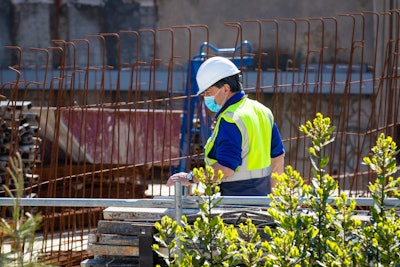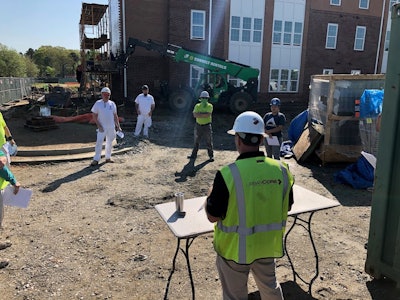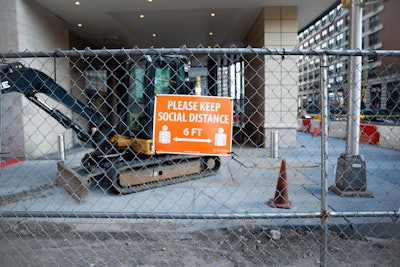
The differences are many: You’ve not seen widespread worker concern over viral contamination from others on the job. You’ve never had to consider the impact of anti-viral PPE and protocols on productivity. And never before have you had construction come full stop in half a month, as it did in several areas.
Contractors, used to a full-speed-ahead mindset, might think “problem over” as states open up. Not so fast.
As the initial stage of the coronavirus pandemic seems to be over, “we are telling our clients that it’s now time to pick up their head and start looking over the horizon and gather sound data and information,” says Brian Moore, principal with construction consultant for FMI.
“Don’t rest on your laurels and think that just because you have a great backlog today with a good margin in it that you’re going to be OK,” Moore says. “Don’t expect that that is going to be all it takes.”
Crew realities
“Contractors need to realize that they are going from business management to emergency management,” says Bo Mitchell, president of 911 Consulting in Wilton, Connecticut. “There needs to be a recognition by the employer that we’re in a dangerous situation, and there needs to be a plan for addressing it. It’s a public health issue as well as a construction site issue.”
How jobs are performed has changed significantly. Workers who could freely enter a jobsite before are now being required to undergo temperature scans, don face masks and stay 6 feet away from others in an environment where people from several trades and companies can be present. All of this is bound to work on people’s psyches.
“The stress and trauma on people who are coming back to jobs is very big,” Mitchell says. “They may not want to work with a bunch of other guys, pick up something and bring it home to their family. I don’t think employers have thought this through.”
Emergency management involves a different model, way of thinking and leading than contractors have had to enact before, Mitchell says. “We’re not introducing a police state to our jobsite, but you need to be out there much more carefully supervising everyone because it’s now doubly dangerous work.”
Your safety manager has to be aware of a new set of guidelines that will likely evolve. There are a lot of guidelines floating around, including ones from OSHA, individual states, unions and consultants like Mitchell. A slew of questions need to be asked: Who is responsible for on-site employee testing, managing cleaning procedures, making sure anti-viral safety protocols are being followed? How are you making sure protocol updates are being incorporated into your safety plan?
 The Associated General Contractors did a coronavirus stand down in April, communicating new jobsite safety protocols.
The Associated General Contractors did a coronavirus stand down in April, communicating new jobsite safety protocols.Although all safety plans need to be coordinated among all contractors on a job, developing and following COVID-19 protocols can be especially problematic because you’re dealing with human-to-human contact. “Some people get tired of the rules about social distancing and face masks,” Mitchell says. “Leadership needs to makes sure this gets done safely.” Enforcement matters.
“There’s an importance for leaders to be leaders in their business,” Moore says. “These are very uncertain times for employees. In times like this when you have great uncertainty in the marketplace, you have to be empathetic with that. Pay attention to your need to communicate, to make sure they know what’s happening.”
The hit on productivity and costs
Jobsite standards just released jointly by the Center for Construction Research and Training and the North America’s Building Trades Unions call for no-touch temperature screening methods, cleaning and disinfecting protocols, providing soap and running water for handwashing and hand sanitizers, among other items.
All of these are now part of the cost of doing business. They also mean that construction can’t proceed at the same pace as before.
“My clients are telling me it will likely reduce their productivity by 25 percent,” says Joe Natarelli, construction leader for accounting firm Marcum LLP. Moore says FMI clients are still unsure as to exactly how much productivity will be lost, but “they know that it will be a lot.”
James MacKay, owner of MacKay Construction in Wilmington, Massachusetts, estimates he’s spending $10,000 to $15,000 a month for added safety measures, including disinfectant, gloves, hand sanitizer and face masks. His company has put in foot-operated, hot-water hand-washing stations outside the portable toilets on some sites. “Each site dictates a different protocol,” he says.
And each operator is given a can of Lysol to spray machines down. MacKay tells them, “I don’t care if you’re the only one running it, just don’t take a chance. There’s no need of it, and you could lose two weeks at a minimum.”
These protocols won’t go away anytime soon, MacKay contends. “I think this is going to be the way of life for about a year.” He anticipates as much as a 20 percent decrease in production as crews are forced to wear face masks in the summer heat.
Instead of trades working side by side, they may be required to work in shifts. “I have one client that has a flag system,” Natarelli says. “When it’s red, no new trades can come onto the site. When it’s yellow, one trade is in the process of moving out, and when it’s green, a new trade can come in.”
 Contractors, now forewarned, should build out their coronavirus scenario plans.
Contractors, now forewarned, should build out their coronavirus scenario plans.“If you’re bidding and getting work today with your productivity rates and cost history of six months ago, you might be a little nervous about what your profitability is going to be,” Moore says. “As you think about the work you’re bidding three months from now, if you haven’t incorporated these new productivity measurements into your cost history, it’s going to impact your profitability.”
Moore points out that contractors could push productivity in the Great Recession by better planning, working harder and better focusing teams. “But today you can’t do that. You can’t push harder. There’s such a great unknown as to what the productivity impact is going to be.”
If you’re not fully thinking through lean construction practices and productivity in your organization, you’re likely going to be at a disadvantage to the companies that are, Moore says. “You’ve really got to be certain that you have the systems in place to think through that plan for that. Your field managers need to be planning for that productivity challenge, and that feedback needs to quickly get back to your estimating team. If you are just leaning on your old information, you’re going to potentially be at a significant disadvantage.”
Business as unusual
“Working capital is one of the most important things for a contractor,” Natarelli says. “I don’t think owners are going to be receptive to contractors who don’t have these issues dealt with on the jobs going forward. Position yourself and your balance sheet to make sure you can capitalize on working in the new normal going forward, which is going to be different. Just thinking you can hit the switch and do what you did before is not going to work.”
The Great Pandemic is a prime example of why contractors should be prepared on their balance sheet. “Fortunately, a lot of companies came into this shock with a reasonably healthy balance sheet or backlog and had business enterprise systems in place and seem to be in a good position to weather this,” Moore says.
Another tactic, especially if the pandemic sees a resurgence this fall, is to begin forming relationships with backup suppliers.
“Make sure you have two or three backup material vendors and they’re not all from one area of the globe,” Natarelli says. “The lowest price isn’t always the best price in this world because it depends on delivery and whether someone can execute.” Nurture those backup vendors with an occasional order that you would have naturally given to your No. 1 supplier.
“It’s a different way of doing business and it’s a way of managing risk,” Natarelli says. Owners should also know that if a backup vendor comes in with higher prices, it’s part of your risk mitigation plan, he says. “That way, if there’s another pandemic, you will have materials to finish your job.”
Construction contracts will need to allow for delays caused by pandemics so that all of the costs of the delay are not on the shoulders of contractors, Natarelli says.
“I think the industry is responding quite well and really making sure in future contracts that this is in there, but they are still going to have to live with present contract language,” Natarelli says. And on multi-year contracts, that could mean another two to three years if no contract adjustments are made.
And let your owners, banks and vendors know what you’re doing to maintain solvency, Natarelli says. “We’ve had some owners asking contractors for cash flows, and I think a lot more owners will now be asking for surety bonds.”
Pricing’s downward trend
“One thing we learned from the last recession is that price wins,” Moore says. Owners know that contractors will have to get smart at being competitive from a price standpoint.
Know your costs, drive every bit of excess you can out of labor, equipment and material costs, Moore says. Manage your profitability expectations.
Also realize there are markets that will be something other than price driven, Moore says. “Really wise contractors are working hard to shore up relationships and to build presence in those markets.”
In private work, these owners are particular about which contractors work for them, Moore says. For these clients, your experience matters. “They like contractors they know because they understand how they do business,” Moore says. “Although it would have been nice to do six months ago, it doesn’t mean you can’t pursue that kind of work now.”
Plan in place
Even though it’s likely that once the pandemic trails off people will return to former ways, companies will need to start considering this sort of scenario in their long-range planning, Moore says. “This was something that very few people had actually planned for. We can now understand what’s possible and what’s probable and plan for that today.”
“No one knew what to do, so they shut construction projects down,” Natarelli says of the early days of the pandemic. “Now if there’s a plan, for example, to reduce the labor down to 25 percent, I think authorities would be much more open to keeping construction going.”
“Contractors should build out the mechanism for scenario planning,” Moore says. “Put people in a (virtual) room to think about strategic possibilities and strategic options and plan for those.”
“The best way for contractors to position themselves going forward is to learn to react to the new normal,” Natarelli says. “This is not going away right away. Learn how to operate in a new employee safety and health environment, material delays, how to mitigate force majeure clauses in contracts going forward.”
Opportunities in the new normal
One fact remains from previous recessions: good people get laid off. If they don’t leave construction, they then become available to other contractors, or form their own firms.
“Hundreds if not thousands of people who were laid off start new companies and start doing things in new ways,” says Frank Stasiowski, founder and CEO of consulting firm PSMJ Resources. “My advice to contractors is to take a look over your shoulder because there’s going to be a whole new wave of competitors who embrace things in a way we haven’t figured out yet.”
“The opportunity now exists to recruit talent in a way that hasn’t existed for years,” adds Anirban Basu, chief economist for Associated Builders and Contractors. “There’s an opportunity for contractors that make it through this period to upgrade their skills quotient.”
The pandemic has exposed many companies’ technological weaknesses. Make sure your technology capabilities can handle demands going forward.
“We see this kickstarting the transition to technology.” Moore says. “Things that we were forced to do digitally will stick because it boosted productivity.”
Communicate with your clients how you are working with your owners, subs and vendors on COVID-19 safety management, Stasiowski says. Learn from one job and relay those lessons to other clients. This type of communication increases client confidence that you’ve considered the risks and encourages them to continue to do projects with you, he says.
There is a future
“The good news is that the demographic demand for construction has not gone away,” Stasiowski says. A growing population still requires housing construction, he says, although where the housing is built may shift.
“I think you’re going to see the move to downtowns slow down, if not reverse,” Stasiowski says. The reason: more people will be working at home and want more space and will therefore find suburbs attractive again.
“Now is the time to recommend bold new approaches to design moving forward,” Stasiowski adds. He says we may see more “residential malls” that have restaurants and social activities as opposed to retail. “That means major changes in the way that things are going to be designed, which also means a lot of construction. Mall properties are not going to be boarded up. Owners will want to modify them to whatever we go to next.”
The pandemic will force societal structural changes in ways the last recession did not, he says. “Now we’re going through a completely different approach by hundreds of thousands of companies who are embracing technology and doing things differently. Our society is going to be different in the way we work and educate our kids. Our construction businesses need to respond to it.”
Stasiowski continues:
“Design construction will be led by the millennials who know how to use technology and couple it with what we’ve done for 100 years. I don’t think it will ever go back to the way it was. What we have now moving forward is a new way of operations in America and the world.”













